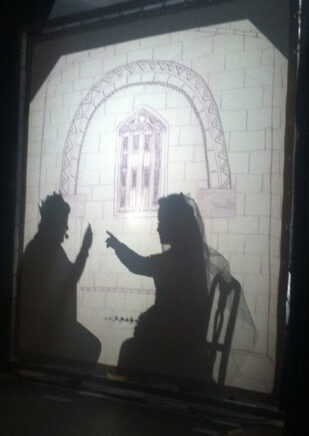Body shadows
Also called “human shadows” or “Spanish shadows”, body shadows are a form of shadow puppetry that was in fashion during the second half of the 18th century. The silhouettes projected on screen were those of the actors and not of cut-out figures. This technique was mostly used in high-society theatres. A technical description of it is given in the foreword “Ce qu’on voudra – Pourvu qu’on le lise” (Whatever you will – Provided that you read it) to L’Heureuse Pêche (1770).
In his Correspondance littéraire, philosophique et critique (Literary, philosophical and critical correspondence, 15 August 1770), Baron Friedrich Melchior von Grimm writes “beside French opera, I do not know of a more interesting type of show for children”; “it is ideal to represent magic, the marvellous and the most dreadful catastrophes. For instance, if you would like the devil to carry someone away, the actor playing the devil would only need to jump over the candle placed at the back, and on the screen it would look like he is flying off in the air with him”.

Works
- L'Heureuse Pêche – 1767
- Sunjata – 1989